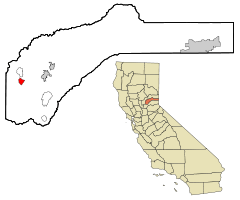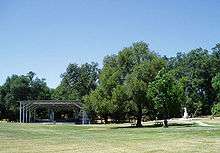Penn Valley, California
Penn Valley is a census-designated place (CDP) in Nevada County, California, United States. The population was 1,621 at the 2010 census, up from 1,387 at the 2000 census.
Penn Valley | |
|---|---|
 Western Gateway Park | |
 Location in Nevada County and the state of California | |
 Penn Valley Location in the United States | |
| Coordinates: 39°11′54″N 121°11′20″W | |
| Country | |
| State | |
| County | Nevada |
| Area | |
| • Total | 2.121 sq mi (5.495 km2) |
| • Land | 2.121 sq mi (5.495 km2) |
| • Water | 0 sq mi (0 km2) 0% |
| Elevation | 1,401 ft (427 m) |
| Population (2010) | |
| • Total | 1,621 |
| • Density | 760/sq mi (290/km2) |
| Time zone | UTC-8 (Pacific (PST)) |
| • Summer (DST) | UTC-7 (PDT) |
| ZIP code | 95946 |
| Area code(s) | 530 |
| FIPS code | 06-56518 |
| GNIS feature ID | 1867050 |
History
The community may be named for one Madame Penn, the original owner of the town site.[2]
Geography
Penn Valley is located at 39°11′54″N 121°11′20″W (39.198214, -121.188965).[3]
According to the United States Census Bureau, the CDP has a total area of 2.1 square miles (5.4 km2), all of it land.
Demographics


2010
At the 2010 census Penn Valley had a population of 1,621. The population density was 764.1 people per square mile (295.0/km²). The racial makeup of Penn Valley was 1,434 (88.5%) White, 9 (0.6%) African American, 34 (2.1%) Native American, 23 (1.4%) Asian, 0 (0.0%) Pacific Islander, 31 (1.9%) from other races, and 90 (5.6%) from two or more races. Hispanic or Latino of any race were 143 people (8.8%).[4]
The census reported that 1,611 people (99.4% of the population) lived in households, 10 (0.6%) lived in non-institutionalized group quarters, and no one was institutionalized.
There were 628 households, 195 (31.1%) had children under the age of 18 living in them, 301 (47.9%) were opposite-sex married couples living together, 91 (14.5%) had a female householder with no husband present, 41 (6.5%) had a male householder with no wife present. There were 36 (5.7%) unmarried opposite-sex partnerships, and 3 (0.5%) same-sex married couples or partnerships. 163 households (26.0%) were one person and 74 (11.8%) had someone living alone who was 65 or older. The average household size was 2.57. There were 433 families (68.9% of households); the average family size was 3.02.
The age distribution was 363 people (22.4%) under the age of 18, 136 people (8.4%) aged 18 to 24, 321 people (19.8%) aged 25 to 44, 506 people (31.2%) aged 45 to 64, and 295 people (18.2%) who were 65 or older. The median age was 44.5 years. For every 100 females, there were 93.7 males. For every 100 females age 18 and over, there were 89.2 males.
There were 666 housing units at an average density of 313.9 per square mile, of the occupied units 485 (77.2%) were owner-occupied and 143 (22.8%) were rented.The homeowner vacancy rate was 2.6%; the rental vacancy rate was 3.3%. 1,186 people (73.2% of the population) lived in owner-occupied housing units and 425 people (26.2%) lived in rental housing units.
2000
At the 2000 census there were 1,387 people, 530 households, and 383 families in the CDP. The population density was 659.3 people per square mile (255.0/km²). There were 561 housing units at an average density of 266.7 per square mile (103.1/km²). The racial makeup of the CDP was 93.4% White, 0.8% African American, 0.6% Native American, 0.7% Asian, 5.5% from other races, and 2.4% from two or more races. Hispanic or Latino of any race were 12.5%.[5]
Of the 530 households 32.8% had children under the age of 18 living with them, 55.3% were married couples living together, 12.1% had a female householder with no husband present, and 27.7% were non-families. 20.6% of households were one person and 9.4% were one person aged 65 or older. The average household size was 2.62 and the average family size was 3.03.
The age distribution was 27.0% under the age of 18, 4.8% from 18 to 24, 26.2% from 25 to 44, 26.3% from 45 to 64, and 15.6% 65 or older. The median age was 40 years. For every 100 females, there were 95.9 males. For every 100 females age 18 and over, there were 93.5 males.
The median household income was $35,962 and the median family income was $37,115. Males had a median income of $33,068 versus $21,133 for females. The per capita income for the CDP was $16,582. About 9.2% of families and 13.0% of the population were below the poverty line, including 22.7% of those under age 18 and 6.6% of those age 65 or over.
Politics
In the state legislature, Penn Valley is in the 1st Senate District, represented by Republican Brian Dahle,[6] and the 1st Assembly District, represented by Republican Megan Dahle.[7]
Federally, Penn Valley is in California's 1st congressional district, represented by Republican Doug LaMalfa.[8]
Tourism
Penn Valley hosts a rodeo event each year in late Spring and has attracted as many as 5,000 spectators during one of its events.[9] The Penn Valley Rodeo is organized by Penn Valley Community Rodeo Association since 2005.[10] In the 1950s, the Penn Valley Fire Dept. needed funds. George Alan Smith, a local cowboy and heavy equipment operator, came up with the idea of holding a rodeo. George talked Pegar (of Pegar's 'Y') into donating the land, and then he leveled and build the grounds with his D-9 CAT bull-dozer. George enlisted the help of friends and relatives on weekends, evenings, and holidays to set posts, build fence and chutes, and put up bleachers. George, a WWII Navy Vet, was the nephew of Jay and Bessie Peacock, owners of the Peacock Ranch (at the top of Pet Hill). In 1951, he married Lynn Margaret Gleason, daughter of Harold & Mildred Gleason who owned the Lazy Valley Angus Ranch, which was the original stage stop between Reno and Sacramento during the Gold Rush. As they built the arena, George and Lynn organized the weekend calf-ropings there. Lynn and other ropers' wives put together a refreshment stand, and their children collected pop bottles under the bleachers, turning them in for the refunds. All of this served to work out any problems with the arena before the big event. The first Penn Valley Rodeos featured intermission entertainment provided by local rancher, Larry Filer and his horse, Jim. Larry claimed that he never trained Jim, and that Jim initiated all his humorous antics. Jim would pull the handkerchief out of Larry's back pocket, count, play dead, take a nap and steal the covers, steal Larry's hat, etc. The first rodeo was a success, and it took on a life of its own. The local Fire Department and residents volunteered to their time and efforts to help put on the annual event. The Penn Valley Rodeo quickly became "the summer event" for people from all over California to attend.[11]
Notable residents
- Chuck Yeager, retired General in the United States Air Force and first man to break the sound barrier.
- Tanner Vallejo, NFL football player.
References
- U.S. Census Archived 2012-01-25 at the Wayback Machine
- "Earliest settlement". Penn Valley Area Chamber of Commerce. Retrieved October 13, 2015.
- "US Gazetteer files: 2010, 2000, and 1990". United States Census Bureau. February 12, 2011. Retrieved April 23, 2011.
- "2010 Census Interactive Population Search: CA - Penn Valley CDP". U.S. Census Bureau. Archived from the original on July 15, 2014. Retrieved July 12, 2014.
- "U.S. Census website". United States Census Bureau. Retrieved January 31, 2008.
- "Senators". State of California. Retrieved March 10, 2013.
- "Members Assembly". State of California. Retrieved March 2, 2013.
- "California's 1st Congressional District - Representatives & District Map". Civic Impulse, LLC. Retrieved March 2, 2013.
- "Penn Valley Community Rodeo -". National Geographic Society.
- "Penn Valley Rodeo Homepage -". Penn Valley Community Rodeo Association.
- Jennifer Smith Mitchell, daughter of George Alan Smith
